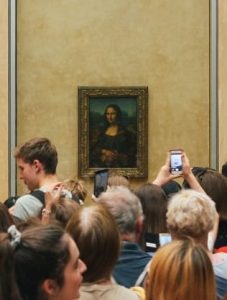Museums, or the treasuries of art, have always been of paramount importance for the cultural development of nations. However, they have not always been very popular among the general audience. These institutions used to be reserved only for the rich and powerful, only to later become accessible and appealing to the educated part of society. But most people see them as stuffy and traditional places, without much going on inside. They are usually related to the past, and not so much to the future and innovations ahead. However, all of these prejudices are about to disappear.
One of the ways that museums are trying to change how people see them is by using Virtual Reality. Not so long ago it was impossible to imagine that you could visit a museum without leaving your home. And not only that. There are several ways that VR technology is changing the museum experience as we know it.
Coming Closer Like Never Before
 Going to a museum to see a painting that you really like is an unforgettable experience. But there are also some negative aspects of visiting a popular work of art. First of all, if you aren’t from that city (or even country) where a particular museum is, the trip itself can be costly and can take a lot of budgeting to afford. And even if you do make it there, the chances of it being overcrowded are high. Therefore, even if you get a chance to avoid the peak of the season, there is a real possibility that you won’t get to enjoy the view peacefully. Moreover, most of these works of art are behind protective glass and can be seen only from a certain distance.
Going to a museum to see a painting that you really like is an unforgettable experience. But there are also some negative aspects of visiting a popular work of art. First of all, if you aren’t from that city (or even country) where a particular museum is, the trip itself can be costly and can take a lot of budgeting to afford. And even if you do make it there, the chances of it being overcrowded are high. Therefore, even if you get a chance to avoid the peak of the season, there is a real possibility that you won’t get to enjoy the view peacefully. Moreover, most of these works of art are behind protective glass and can be seen only from a certain distance.
This is the case of the famous Mona Lisa painting. However, with a new VR experience, Louvre is offering its fans a new way to perceive Mona Lisa, without any glass protection or other people around you. This VR presentation shows the viewer the woman in the painting up close and personal, and all the reasons why this is one of Leonardo Da Vinci’s greatest works of art.
Accessible To Everyone
Like was mentioned earlier, visiting a museum can take a lot of planning and budgeting. On the other hand, museums are supposed to be cultural headquarters that enlighten and inspire the general public. And with VR technology, this has become a reality for people worldwide. People can be prevented from visiting a certain museum for different reasons. For example, people with disabilities can be prevented from enjoying a crowded museum, or in some cases, they can’t even leave the house. For these and many other cases, VR technology has opened many doors to new museum-goers who can now enjoy the magnificent works of art from the comfort of their home.

Inspiring Curiosity
When VR experience was first brought into connection with museums, there was a certain level of fear that it might cause a fall in the existing number of museum-goers. However, this couldn’t be further from the truth. If anything, VR experience of a museum has been inspiring people to actually perceive museums in a different way. What once was thought of as a boring and uninspiring has become exciting and appealing.
VR experience has served as a commercial to many museums to attract new visitors. Additionally, many museums have been inspired by the growing interest, so they have prepared special virtual presentations for the viewers to show them a different side of culture. VR tour of any museum has only proven that these traditional institutions know how to keep up with the future in order to preserve the remnants of the past.
